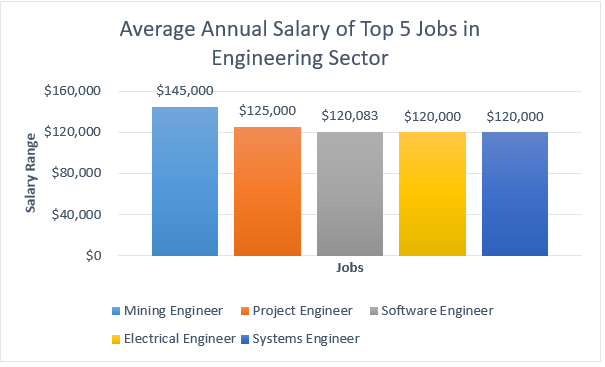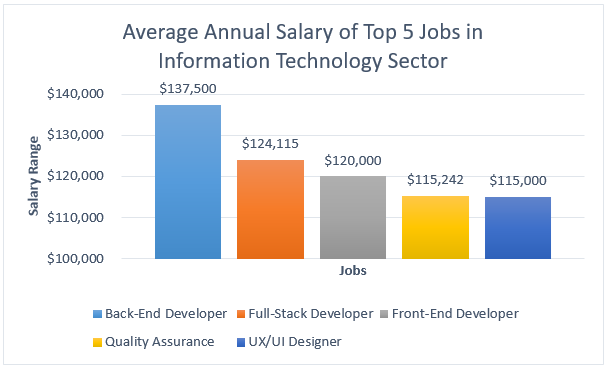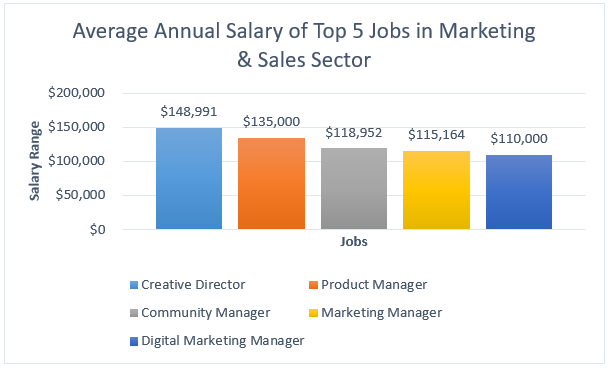Average salary in Australia in 2024 – The ultimate guide

This article covers:
- Factors Affecting Salaries
- Industry Wise Average Weekly Salary in Australia (Full-Time Employees)
- Average Salary for Full-Time Worker in Australia
- Average Salary for Part-Time Workers in Australia
- Average Salary in Australia: State Wise
- Highest Paying Jobs in Australia
- Lowest/Minimum Paying Jobs in Australia
- Salary for Experience
- Before you go…
Average annual salary in Australia: Over $90,000
Full-time workers: $92,029.60 pre-tax income annually
Part-time workers: $67,521 average annual salary
If you are planning to work abroad, Australia will certainly be one of the top countries on your mind. The largest country in Oceania is counted amongst the countries with the highest standards of living in the world, making it one of the preferred countries to live in.
Moreover, the natural ecosystem, multi-cultural society, world-class education, excellent healthcare system, welcoming government policies and ample work opportunities are reasons why Australia has seen a spike in the number of immigrants over the years.
However, before deciding to move to “the Land Down Under”, it is important to learn about their work regulations, requirements and average salary in your chosen field. Australia has a thriving economy. Thus, the average salary in Australia is among the best in the world, but knowing the pay scale in Australia is imperative. The guide below shall help you learn more about salary in Australia in various sectors, provincial salary variations and the key factors that affect the same.
Key Points:
- The average annual salary in Australia exceeds $90,000, with full-time workers earning an annual pre-tax income of $92,029.60, while part-time workers have an average annual salary that goes up to $67,521.
- According to data released by the OECD (Organization for Economic Co-operation and Development), Australia is among the top 10 countries with the highest annual average wages.
- The average weekly earnings in Australia for full-time employees has increased by 3.9% annually to $1,838 in May 2023, according to the Australian Bureau of Statistics (ABS).
Factors Affecting Salaries
No two individuals are the same, and everyone brings a unique set of skills to their job. Hence, salary variation is pretty common even for the same occupation. Some of the factors affecting salaries are:
- Education level: Salary by education level is one of the most important factors determining the salary pay scale.
- Experience and skills: Typically, the longer you are involved in a job, the more productive you get. The skill sets get more refined, and the ability to handle tasks and challenges at work improves.
- Geographical location: Some cities and states offer higher salaries for the same job. This is because the cost of living plays an important role in determining salary.
- Demand and supply, inflation and government regulations: The workforce demand and supply, prevailing inflation rates, and changes in government regulations on wages are some economic factors affecting salaries.
- Labour unions: In some organisations or areas, labour unions have a proactive role and higher bargaining strength that influence employee salary.
- Employer: Salaries predominantly vary based on industry, job profile and employer. But, within the same industry, the employer’s ability to pay depending on the clientele and working conditions plays a vital role.
Must Read: Top 10 Part-time Jobs for Students in Australia 2024
Industry Wise Average Weekly Salary in Australia (Full-Time Employees)
Below is the industry-wise average salary data of Australia.
|
Industry |
Average Weekly Earnings (AUD) |
|
Mining |
2,854.00 |
|
Information media & telecommunications |
2,317.90 |
|
Professional, scientific & technical services |
2,170.90 |
|
Financial & insurance services |
2,159.70 |
|
Electricity, gas, water & waste services |
2,155.40 |
|
Public administration & safety |
1,964.50 |
|
Education & training |
1,949.70 |
|
Health care & social assistance |
1,807.70 |
|
Construction |
1,802.80 |
|
Transport, postal & warehousing |
1,799.70 |
|
Rental, hiring & real estate services |
1,719.70 |
|
Wholesale trade |
1,685.00 |
|
Arts & recreation services |
1,653.30 |
|
Manufacturing |
1,631.10 |
|
Administrative & support services |
1,616.40 |
|
Retail trade |
1,383.70 |
|
Other services |
1,382.70 |
|
Accommodation & food services |
1,346.80 |
Source: Australian Bureau of Statistics
Average Salary for Full-Time Worker in Australia
Before we dive into the statistics, it is crucial to understand the difference between Australia’s median income and average income. The average salary is calculated by adding all the salaries in a group and then dividing it by the total employees. On the contrary, the median salary is just the specific point in the distribution that comes in the middle.
An Australian now requires more than $90,000 annual salary to lead an above-average lifestyle. With the cost of living increasing every year, understanding Australian salary trends has become important. Also, to set realistic goals, knowing about the average income in Australia is essential.
Let us look at the Australian salary comparison of top sectors. The table below shows the sectors with the highest average salary in Australia per month and year for a full-time employee.
|
Sectors |
Average Salary in Australia Per Month (AUD) |
Average Salary in Australia Per Year (AUD) |
|
Engineering |
9,519 |
114,223 |
|
Information Technology |
9,184 |
110,209 |
|
Science |
9,118 |
109,417 |
|
Healthcare, Pharmaceutical & Social Services |
8,809 |
105,705 |
|
Marketing & Sales |
8,228 |
98,734 |
Source: Talent
Must Read: How much does it cost to live in Australia?
Let us now look at the average wage in Australia in the top 5 jobs in each sector.
Send money to 60+ countries

Sector 1: Engineering

Source: Talent
Sector 2: Information Technology

Source: Talent
Sector 3: Science

Source: Talent
Sector 4: Healthcare, Pharmaceutical & Social Services

Source: Talent
Sector 5: Marketing and Sales

Source: Talent
Average Salary for Part-Time Workers in Australia
According to the Labour Force data for September 2023, released by the Australian Bureau of Statistics (ABS), below are the two major findings related to the part-time workforce in the country.
- The number of people working part-time increased by 23,600 to 4,269,600 in September 2023.
- Part-time employees currently account for 30.2% of the total workforce.
The above numbers prove a significant demand for part-time employees in Australia. We can divide the part-time workforce in Australia primarily into students and non-students. Out of this, students contribute a major portion of the part-time workforce. A significant number of international students, as well as locals, prefer working part-time to manage their finances, get work experience, learn more about various cultures, etc.
Major sectors where part-time recruitment takes place in Australia include:
- Food and Beverages
- Retail
- Hospitality
- Delivery
- Administrative
- Writing
These sectors offering multiple opportunities with flexible schedules are perfect for students, individuals who wish to work in more than one part-time job, people already with full-time jobs but looking to earn extra and home-makers or retired individuals.
A part-time worker’s average per-hour salary in Australia is $34.63 or $67,521 annually. It must be noted that the part-time salary also varies from one individual to another based on factors like industry and job profile, skills, location, etc.
The top 5 highest-paying part-time jobs for students in Australia are:
|
Type of Job |
Average Salary in Australia (AUD) (Part-Time) |
|
Aged care worker |
35 |
|
Sales representative |
30 |
|
Customer Service |
26 |
|
Server |
25 |
|
Tutor |
20 – $40 |
Also Read: Australian citizenship for Indians 2024
Average Salary in Australia: State Wise
According to the Average Weekly Earnings report by the Australian Bureau of Statistics, the full-time average weekly earnings for individuals in May 2023 was $1,838.10, a 3.9% increase from the previous year. Below are the state-wise or provincial salary variations in Australia.
|
State |
Average Weekly Ordinary Time Earnings |
||
|
Total (AUD) |
Males (AUD) |
Females (AUD) |
|
|
Overall Australia |
1,838.10 |
1,938.30 |
1,686.00 |
|
Western Australia |
2,039.30 |
2,216.30 |
1,741.70 |
|
Australian Capital Territory |
2,022.90 |
2,129.00 |
1,911.40 |
|
Victoria |
1,832.90 |
1,933.50 |
1,683.70 |
|
New South Wales |
1,831.90 |
1,924.80 |
1,697.00 |
|
Queensland |
1,791.00 |
1,887.80 |
1,637.80 |
|
Northern Territory |
1,775.90 |
1,912.10 |
1,614.10 |
|
South Australia |
1,677.80 |
1,717.00 |
1,601.80 |
|
Tasmania |
1,619.30 |
1,652.10 |
1,565.70 |
Highest Paying Jobs in Australia
As of September 2023, the employment-to-population ratio in Australia remained at 64.4%, as per the Labour Force Australia report. This ratio provides the measure of employment in relation to the size of the population.
Some of the highest-paying jobs in Australia are:
|
Job Title |
Average Annual Salary (AUD) |
|
Ophthalmologist |
457,687 |
|
Internal medicine physician |
230,946 |
|
Anaesthetist |
175,456 |
|
Vice president of compliance |
161,963 |
|
Chief financial officer |
144,790 |
Source: Indeed
Lowest/Minimum Paying Jobs in Australia
Before we discuss the lowest minimum-paying jobs in Australia, it is important to know the minimum wage in Australia. The Fair Work Commission sets and reviews the minimum wages in Australia and operates under the Fair Work Act 2009.
The national minimum wage is the minimum base wage you are entitled to earn in Australia. As of 1st July 2023, the national minimum wage in Australia for full-time workers is $23.23 per hour or $882.80 per week (before tax). This is an 8.6% increase from the previous minimum wage rate. This minimum wage rate, however, does not include the following categories of workers:
- Junior workers (under 21 years)
- Supported Wage System workers
- Apprentices and trainees
Below are some of the lowest-paying jobs in Australia:
|
Job Title |
Per-Hour Salary in Australia (AUD) |
|
Office cashier or checkout operator |
18.68 |
|
Sales Assistant |
23.79 |
|
Dishwasher |
23.83 |
|
Laundry worker |
24.96 |
|
Waiter |
26.17 |
It is essential to understand that the jobs mentioned above are typically part-time and mainly offered to students or individuals without formal degrees. Many people prefer working in multiple part-time jobs to make ends meet. Also, the above-mentioned hourly rates are the basic salary in Australia, which does not include tipping.
Salary for Experience
Experience indeed plays an important factor in determining how much an individual earns. Salary for experience ensures the employees are paid fairly based on their skills, knowledge and ability to handle tasks. Individuals with more experience tend to develop new skills, polish existing skill sets, become more efficient, and easily handle more complex tasks. Hence, many employees expect that their pay will increase by gaining more experience and new responsibilities.
For example, an entry-level software engineer may earn around $80,109 annually, and a senior software engineer can earn around $141,703 annual basic salary in Australia. Take a look at the below table to understand better.
|
Years of experience |
Earning Expectation |
|
2-5 years |
32% more than entry-level joiners. |
|
5-10 years |
36% more than people with less than five years of experience |
|
10-15 years |
21% more than people with less than ten years of experience |
|
>15 years |
14% more than people with less than fifteen years of experience |
Moreover, underestimating your experience can lead to lower pay scales in Australia, whereas overestimating it may put you in a challenging position. Therefore, both the employee and the employer must understand the job profile and responsibilities better to value experience during salary negotiations.
Besides the number of years of experience, employers may also consider the quality and relevance of the projects handled and their ability to adapt and learn new skills before hiring.
Before you go…
Australia is amongst the best places in the world to work and live. Due to its significant growth over the years, the average salary in Australia shows an upward trend. The above information on Australian salary comparison for various industries and across jobs can help you negotiate better and understand the current job market. Apart from these details, if you are planning to move to Australia for work, you must also be aware of the best options to send money from Australia.
Instarem is an easy-to-use, fast*, low-cost#, cross-border payment method that makes overseas money transfers a breeze. What’s more? You can transfer money to more than 60 countries, get better exchange rates, full transparency on transactions, earn rewards on each transaction, and much more!

*rates are for display purposes only
Try Instarem for your next transfer.
Download the app or sign up here.
Other Related Blogs:
Disclaimer: This article is intended for informational purposes only. All details are accurate at the time of publishing. Instarem has no affiliation or relationship with products or vendors mentioned.


























